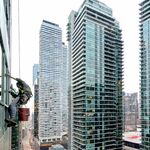You may have misinterpreted the renderings/maps. The coloured segments are just painted road for the duration of the pilot. There are no concrete slabs/plinths.
The city has ordered a large amount of planters that will be arriving next month. These will be placed along the curb lanes to demarcate the pedestrian areas like was done on John St.
[...]
Like loading areas and taxi stands, the streetcar stops will be "cut out" into these but the painted road, ramp and bright yellow textured line will make it immediately obvious that it's a streetcar stop — not to mention the people standing in it. The road murals at streetcar stops will be painted in the Spring.
Over the duration of the pilot — mostly in the Spring/Summer — these areas will be programmed to create a sort of year long street festival that should change King St. from appearing so bleak and a waste of space.
Indeed you are correct. I'd seen an earlier render which showed the raised 'bump-outs' from the sidewalk.
Here's what the City website shows:
[...]
https://web.toronto.ca/city-governm...realm/#tab-tactile-walking-surface-indicators
I see a lot of problems with this as per conflicts of vehicles, cyclists and waiting passengers. The planters, as they are for cycling infrastructure, are necessary now, even if not planted, some physical barrier is needed, and slippery yellow tactile strips isn't it. Many cycle forums are 50/50 on whether cyclists have slipped going *across them* (they are required in the US under Access legislation). Going *along them* when wet or icy? This is a recipe for disaster.
Perhaps pressure to delineate the streetcar area with a sidewalk extension is necessary now...
The implementation of concrete barriers will do more to prevent cars from misbehaving than either signs or law enforcement.
They will continue to be necessary even after more permanent infrastructure is installed. It's not just *regular* dangerous motorists, it's ones with terrorist intent, and NYC was the latest to show how that can unfold.
Your skepticism is healthy and warranted, because all it will take is a major hiccup for this all to go wrong. The barriers are an intrusion, albeit the wrapping at least softens the brutal concrete look, but they are prerequisites.
Like loading areas and taxi stands, the streetcar stops will be "cut out" into these but the painted road and bright yellow textured line will make it immediately obvious that it's a streetcar stop
It brings me back to trying to share space with too many users though. Unfortunately, the name of the game is compromise, huge amounts if you regard the continued car use and lack of right turn requirements at far too many intersections....and now regard what is left for cyclists, since the decision has been made to accommodate them too.
It's a tightrope ride, between the near track rail, with or without a streetcar on it, and the tractably unstable, unpredictable yellow tactile strip.
What cyclist in their right mind is going to temp that? Lots will, but I stated "in their right mind"...which then leaves risk-takers and yahoos cycling through there. Not the right factors for shared use with pedestrians. Best to require, like the Bourke Mall and others do, that cyclists walk as pedestrians for the last block to access their destination along there.






